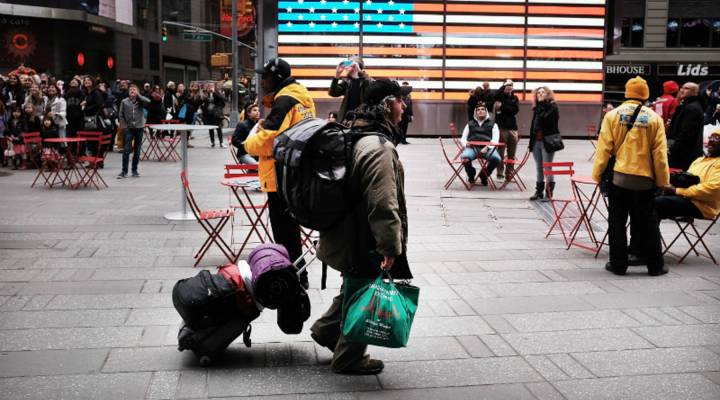
Behind New York’s Right to Shelter policy

This story has been updated.
As New Yorkers face rising rents and stagnant wages, the city has seen a spike in homelessness. Around 60,000 New Yorkers currently live in municipal shelters. They are guaranteed a “Right to Shelter” that stems from an unprecedented 35-year-old lawsuit.
In 1979, Robert Hayes, a 26-year-old newly minted securities and anti-trust litigator with the white-shoe firm of Sullivan & Cromwell brought a class-action lawsuit on behalf of homeless New Yorkers. Hayes was a lawyer who had retained a habit from his days as a young journalist: He chatted with people he met on the street. In the late ’70s, those included homeless men who lived on the streets around NYU School of Law.
“Most people in New York either ignored homeless people or just figured they were out there by choice,” Hayes said. “Free-thinkers, free-livers or down-and-out drunks.”
Instead, the men told Hayes that living on the streets was their only choice in the absence of city shelters. The “flophouses” that catered to needy men were dirty, degrading and dangerous.
At the time, Kim Hopper, also in his 20s, was a graduate student in public health at Columbia University. Hopper, who is now a professor at Columbia’s Mailman School of Public Health, spent time documenting what life was like for mentally ill homeless men living on the Bowery, New York City’s Skid Row.
“Unless you could find a place to squirrel yourself away during the winter months and cadge some heat, you were really exposed to the elements, and that was a really harsh place to be,” Hopper said.
Hopper remembers being introduced to Hayes and hearing that the young lawyer planned to sue to guarantee homeless New Yorkers a right to shelter.
“Here’s this Wall Street lawyer who thinks he can move heaven and hell, let alone the city and state, to establish a right to shelter for people who nobody gave a damn about,” Hopper said.
To Hayes, who is currently the CEO of the nonprofit Community Healthcare Network, it was simple. “Look,” he said, “you see a problem. If you’re a journalist, you write about it; if you’re a poet, you probably write a poem about it.”
And if you’re a lawyer, you take someone to court. Hayes sequestered himself in the basement of the NYU law library and emerged with a relatively simple argument. In 1938, during the Depression, New York rewrote its state constitution, adding a provision that states, “the aid, care and support of the needy are public concerns and shall be provided by the state….”
That was to be Hayes’ argument in court.
“At the end of the day, the best argument I had was, your honor, the word ‘shall’ provide emergency shelter,” Hayes remembered. “Shall means shall; that’s not complicated.”
Callahan v. Carey went before a judge in 1979. Hugh Carey, the defendant, was New York’s governor. Hayes was also suing Mayor Ed Koch and the city’s Department of Social Services. The plaintiff, Robert Callahan, was a homeless man whom Hayes had met on the Bowery.
“Callahan was a spry, alcoholic guy who was in his 50s,” Hayes remembered. “Literally said, ‘I’m ready, let’s take on this Gov. Carey. It’ll be one Irish guy whopping another Irish guy.’ So that was the spirit.”
In December 1979, with winter looming, a judge found for Hayes and ordered the city to make shelters available. To Hayes, it was a win with an asterisk. He knew that many of the city shelters were crowded, dirty and violent. He went back to court, calling witnesses who could testify to the inhumane conditions of the city shelters. The testimony of a young Catholic worker named David Beseda was so powerful, Hayes and Hopper remembered, that once the judge had heard it, they were certain the case had been won.
“That afternoon, the city freaked out and came to the bargaining table, and we started negotiating a consent decree,” Hayes said.
The win affirmed the Right to Shelter. The decree came too late for the plaintiff, Robert Callahan. His died sleeping on the streets in lower Manhattan before it was signed. His death, said Hayes, was attributed to natural causes.
Hayes went on to co-found the Coalition for the Homeless with Hopper and Ellen Baxter. He knows Callahan v. Carey was a big win, but said he also felt a sense of failure. Youthful optimism had convinced him he’d see the end of homelessness, but he said the 60,000 New Yorkers currently living in shelters prove he came up short.
There’s a lot happening in the world. Through it all, Marketplace is here for you.
You rely on Marketplace to break down the world’s events and tell you how it affects you in a fact-based, approachable way. We rely on your financial support to keep making that possible.
Your donation today powers the independent journalism that you rely on. For just $5/month, you can help sustain Marketplace so we can keep reporting on the things that matter to you.












